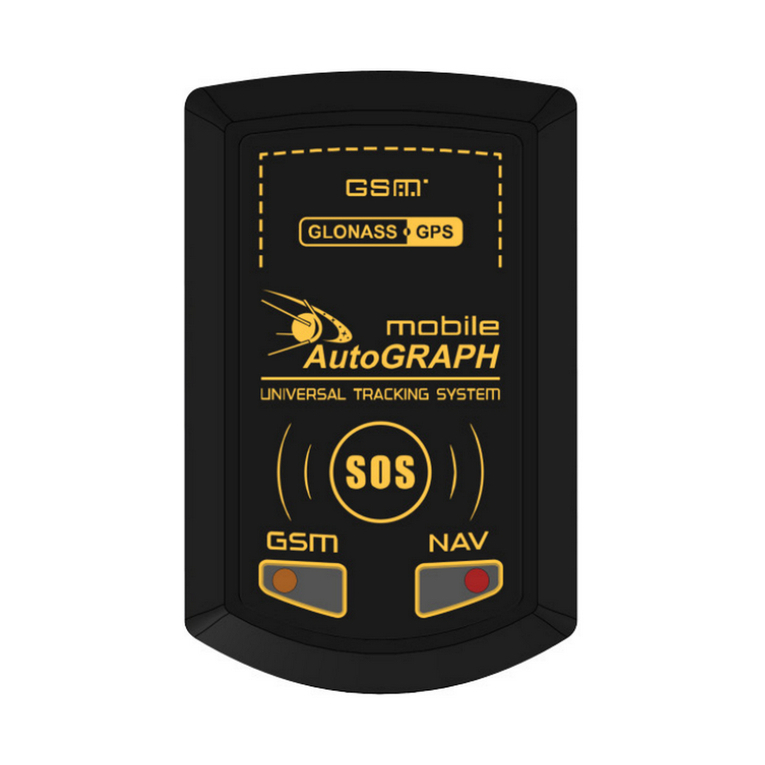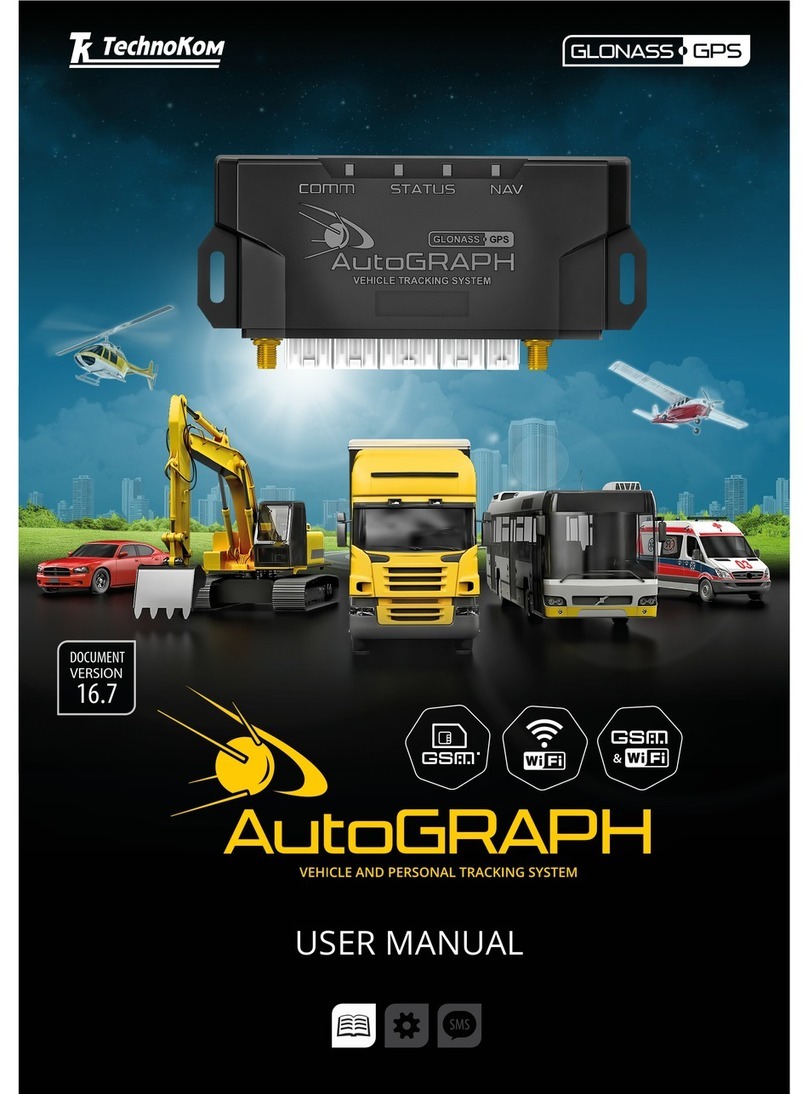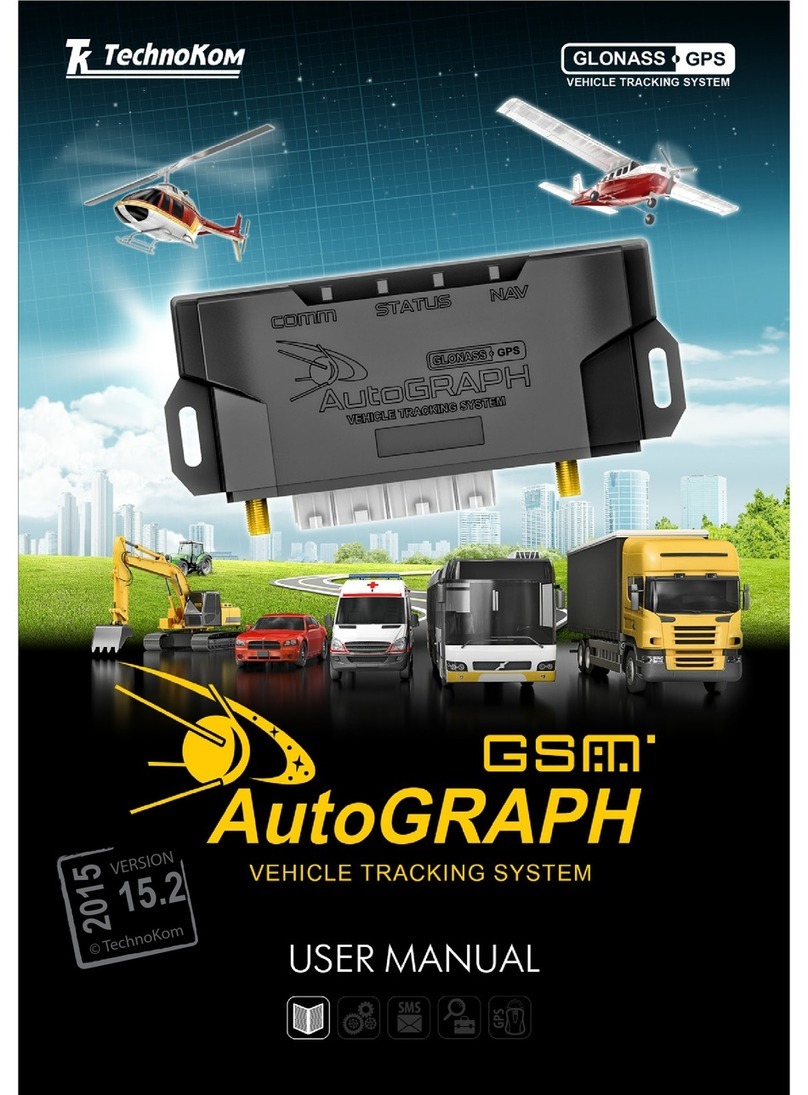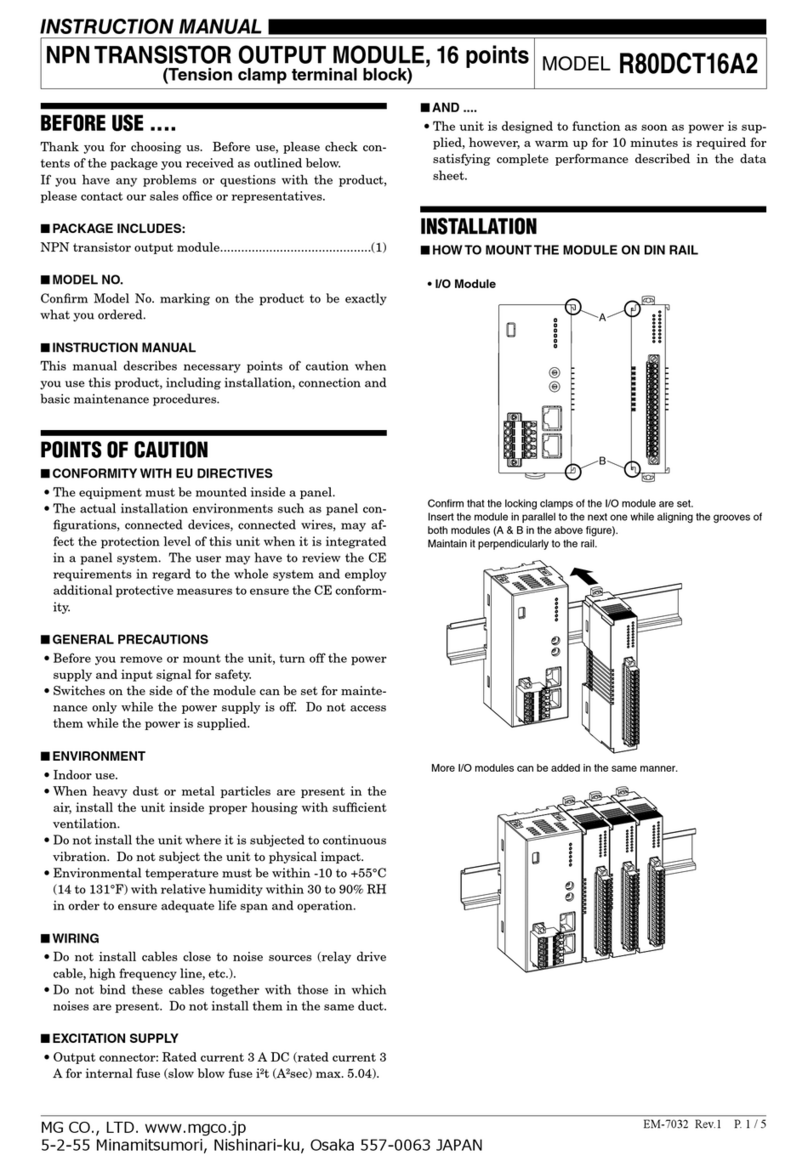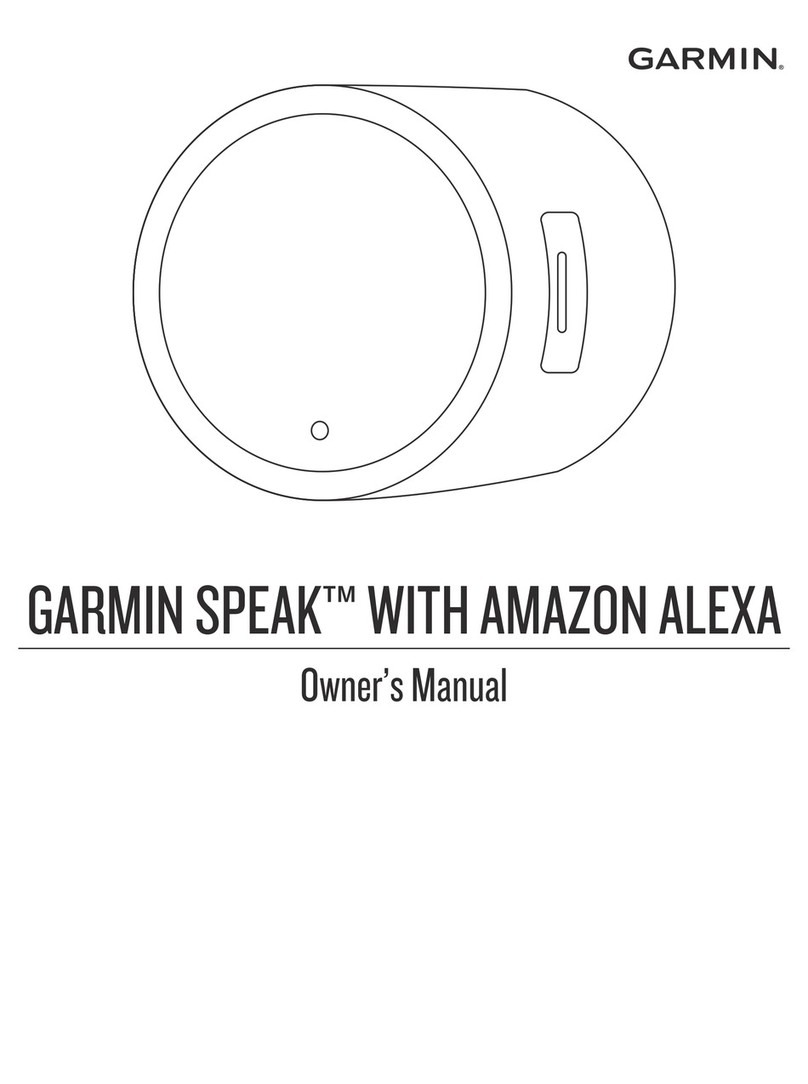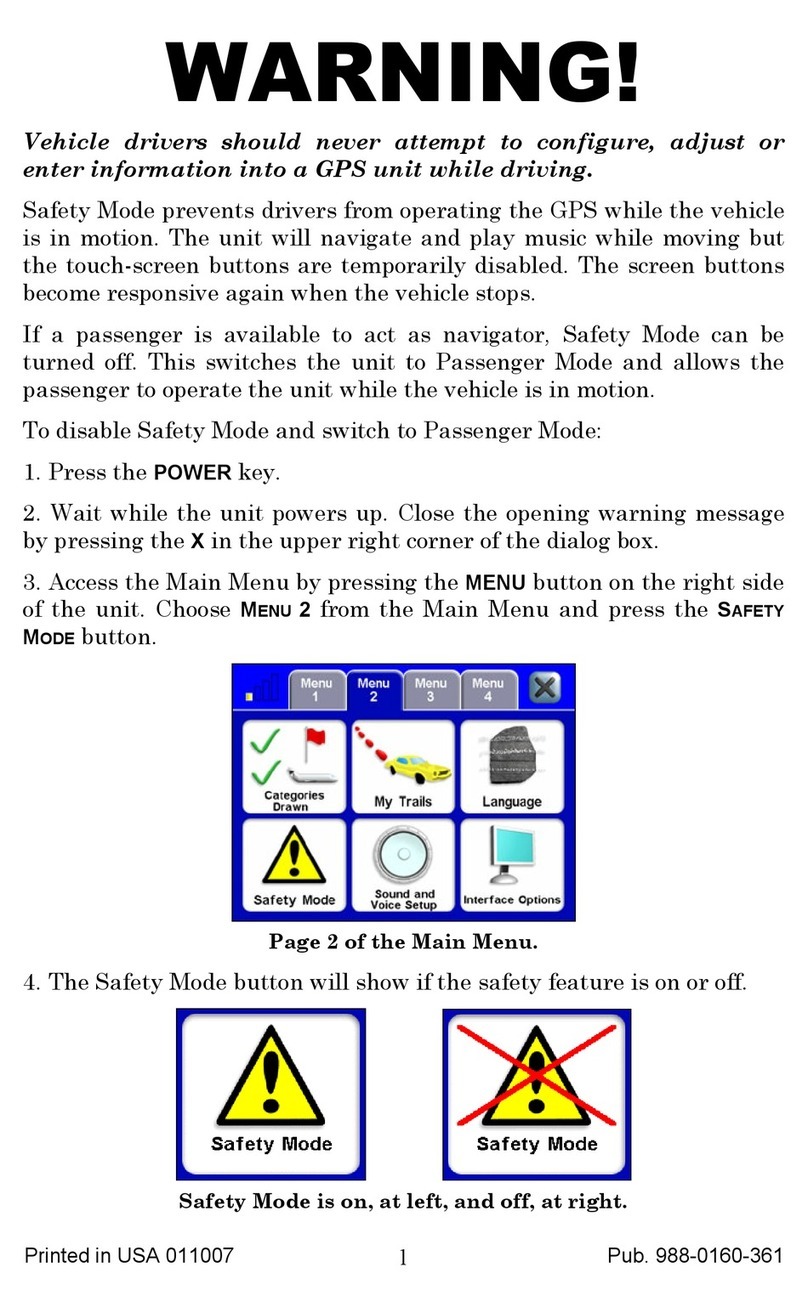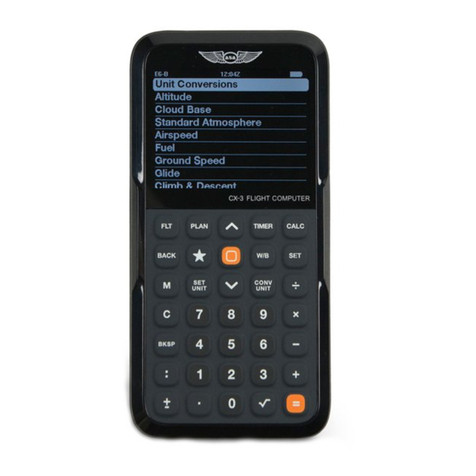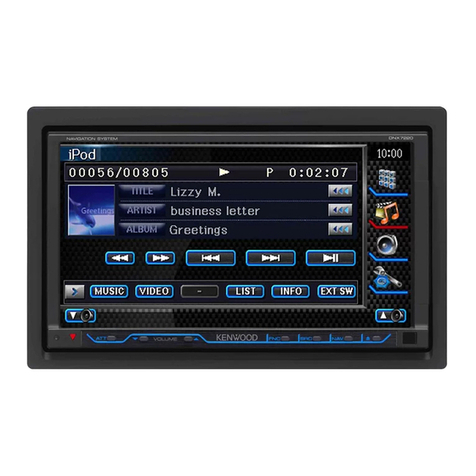TechnoKom AUTOGRAPH GSM SL User manual

2.
2
2015

АвтоГРАФ-GSM/SL • USER MANUAL
2
TechnoKom © 2015

АвтоГРАФ-GSM/SL • USER MANUAL
3
TechnoKom © 2015
Table of Contents
Software Copyright Notice............................................................................................................................... 3
Introduction ............................................................................................................................................................3
Safe Operation and Exposure to Electromagnetic Fields .................................................................. 5
Basic Information ................................................................................................................................................ 7
Technical Specications .................................................................................................................................. 7
Scope of Supply .................................................................................................................................................. 9
Components of AutoGRAPH-GSM/SL Controller............................................................................... 10
Interface Connectors ......................................................................................................................................11
Structure Diagram of AutoGRAPH-GSM/SL......................................................................................... 12
Brief Description of Vehicle Tracking System Operation ................................................................ 18
Connection of AutoGRAPH-GSM controller.......................................................................................... 21
Installation of SIM-cards................................................................................................................................ 22
Installation of a GPS/GLONASS Antenna ............................................................................................. 23
Installation of a GSM Antenna .................................................................................................................... 24
Power Supply Connection ............................................................................................................................ 25
Connection of Digital Input 1 (active low)............................................................................................... 26
Connection of Digital Input 2 (active high)............................................................................................. 29
Connection of High-impedance Digital Input ........................................................................................ 31
Connection of Output...................................................................................................................................... 32
RS-485 Bus (TIA / EIA-485-A).................................................................................................................... 33
CAN Bus (SAE J1939 / FMS) ..................................................................................................................... 36
Indication of Operation................................................................................................................................... 37
Installing the Drivers........................................................................................................................................ 39
Connection of Controller to PC................................................................................................................... 41
Transportation and Storage of Controller............................................................................................... 42
Appendix 1. Warranty Provisions (summary) ....................................................................................... 43
Appendix 2. Certicates of Conformity.................................................................................................... 45

АвтоГРАФ-GSM/SL • USER MANUAL
4
TechnoKom © 2015
This User Manual applies to the
AutoGRAPH-GSM/SL on-board vehicle
tracking controller of rev. 7.1 (hereafter -
tracker, device) produced by TechnoKom
Ltd*. It contains installation and connection
procedures of this device, as well as its
function and control. This Manual constitutes
the Operating Rules to be observed to ensure
successful operation of the controller and its
compliance with TU 6811-002-12606363-
2013 and warranty provisions.
The Manual is intended for specialists who
are aware of maintenance and installation
principles typical for motor vehicles and are
procient in using the electronic and electrical
equipment of various vehicles.
To ensure the best performance of
AutoGRAPH-GSM/SL controllers, they
should be installed and set up only by
qualied specialists.
For proper operation of AutoGRAPH-GSM/
SL controllers, a user should be aware of
operating principles of the vehicle tracking
system as a whole, as well as understand
functions of its individual components.
Therefore, it is highly recommended to
study the fundamentals of operation of
GPS navigation, GSM communication,
peculiarities of short message service (SMS),
GPRS and the Internet before starting.
Introduction
Software Copyright Notice
Products of TechnoKom referred to in this Manual may incorporate software stored in
semiconductor memory or other media, copyrights to which belong to TechnoKom or third
parties. Laws of the Russian Federation and other countries secure certain exclusive rights
of TechnoKom and third parties to the software, which is subjected to copyright, for example,
exclusive rights for distribution or reproduction.
Therefore, any alteration, reverse engineering, distribution or reproduction of any software
incorporated in TechnoKom products, is prohibited to the extent provided by law.
Furthermore, purchase of TechnoKom products does not imply direct, indirect or other
granting of any licenses related to copyrights, patents and patent applications of TechnoKom
or any third party, except for an ordinary, non-exclusive free license for use, which is granted
in virtue of law upon each sale of the product.
Communication protocol between AutoGRAPH-GSM/SL on-board vehicle tracking controllers
and communication data server is considered to be condential information and intellectual
properly of TechnoKom.
The communication protocol between AutoGRAPH-GSM/SL on-board vehicle tracking
controllers and a communication data server shall be transferred by TechnoKom to integrators
and software manufacturers only upon signing the Condentiality Undertaking.
Unauthorized distribution of protocol being used for communication between
AutoGRAPH-GSM/SL on-board vehicle tracking controllers and communication data server
is strictly prohibited.
* AutoGRAPH-GSM/SL controllers of rev. 7.1 are produced from serial № 2008250.

АвтоГРАФ-GSM/SL • USER MANUAL
5
TechnoKom © 2015
Some functions of AutoGRAPH-GSM/SL controllers depend on capacities and conguration of the
existing mobile network operator (MNO).
Furthermore, some functions may be disabled by the operator, or their operating range may be
limited due to the settings of the network. To check availability of a certain function, contact your
mobile network operator.
All information on functions, functional capabilities and other specications related to
AutoGRAPH-GSM/SL on-board vehicle tracking controllers, as well as all information contained in
this User Manual is based on current data (at time of writing) and is deemed to be valid as of the
date of publication.
TechnoKom reserves the right to modify the information or specications without prior notice or
commitment.
IMPORTANT
IMPORTANT
Version history
This table provides a summary of the document revision
Version Description Date
1.0 Initial release 04/2013
1.1 Added description of the device operation with two SIM cards and
instruction of the second SIM installation
06/2013
2.0 New release intended for the AutoGRAPH-GSM/SL rev 7.1 02/2014
2.1 Re-design of the document using brand identity 08/2014
2.2 Updated technical specication 02/2015

АвтоГРАФ-GSM/SL • USER MANUAL
6
TechnoKom © 2015
Safe Operation and Exposure to
Electromagnetic Fields
This section contains important information
for effective and safe operation. Please
read the information below before using
the AutoGRAPH-GSM/SL on-board vehicle
tracking controller.
Performance Characteristics
AutoGRAPH-GSM/SL on-board vehicle
tracking controllers operate using a GSM/
GPRS module and function as a low
power receiver and transmitter. When the
device is ON, it receives and transmits
electromagnetic energy in the radiofrequency
range. Operating band of the device ranges
from 900 MHz to 1,990 MHz; the device uses
digital modulation techniques.
When the device is in operation, a call service
system controls the strength of sent-out RF
signal.
Russian National Standards
(GosStandart)
AutoGRAPH-GSM/SL on-board vehicle
tracking controllers are designed on the
basis of TU 6811-002-12606363-2013 and
comply with the following standards:
• GOST R MEK 60950-2009. Information
Technology Equipment. Safety.
• GOST R 51318.22-2006. Electromagnetic
Compatibility of Technical Equipment. Infor-
mation Technology Equipment. Man-Made
Radio Disturbance. Limits and Methods of
Measurement.
• GOST R 51318.24-99. Electromagnetic
Compatibility of Technical Equipment. Immu-
nity of Information Technology Equipment.
Requirements and Test Methods.
• GOST R Certicate of Conformity: GOST
R № ROSS RU.MN11.H07574.
• TR CU Certicate of Conformity: TS RU
D-RU.AI30.B.00059.
Exposure to Electromagnetic
Fields
The design of the AutoGRAPH-GSM/SL on-
board vehicle-tracking controller complies
with the following national and international
standards, which specify the safe levels of
exposure to radiofrequency electromagnetic
elds:
• Ministry of Information Technologies
and Communications of the Russian
Federation. Regulations for application of
user equipment (user radio stations) within
GSM-900/1800 mobile telecommunication
networks, approved under Order of
Ministry of Information Technologies and
Communications of the Russian Federation
No. 114 dated September 20, 2005
(registered with Ministry of Justice of the
Russian Federation on Sep. 28, 2005 under
No. 7045).
• United States Federal Communications
Commission, Code of Federal Regulations;
47 CFR part 2 sub-part J.
• American National Standards Institute
(ANSI) / Institute of Electrical and Electronic
Engineers (IEEE) C95.
• Institute of Electrical and Electronic Engi-
neers (IEEE) C95 1-1999 Edition.
• National Council on Radiation Protection
and Measurements (NCRP) of the United
States, Report 86, 1986.
• International Commission on Non-Ionizing
Radiation Protection (ICNIRP) 1998
• National Radiological Protection Board of
the United Kingdom 1995.
• Ministry of Health (Canada) Safety Code
6. Limits of Human Exposure to Radiofre-
quency Electromagnetic Fields in the Fre-
quency Range from 3 kHz to 300 GHz, 1999.
• Australian Communications Authority Ra-
diocommunications (Electromagnetic Ra-

АвтоГРАФ-GSM/SL • USER MANUAL
7
TechnoKom © 2015
diation - Human Exposure) Standard 1999
(applicable to wireless phones only).
In order to ensure the best communication
quality and compliance with the safety
standards stipulated by the abovementioned
documents, the equipment operating rules
must be followed.
Antennas
Use only original supplied antennas.
Antennas that have been modied may
damage the device or cause violations of
statutory rules and regulations.
DO NOT touch the GSM antenna of the
device while it is in operation. This can impair
communication quality and give rise to an
undesired increase in radiated power.
DO NOT touch the GPS antenna of the
device while it is in operation. This can
impair the quality of reception and result in
inaccurate positioning.
DO NOT use a device with a defective
antenna. If there are any defects in antenna
or antenna cable, replace the antenna or
consult your local dealer as soon as possible.
Electromagnetic Interference and
Compatibility
Almost any electronic device is subjected
to electromagnetic interference unless it is
adequately shielded, has proper construction
or is compatible with devices operating in
another frequency band.
Prohibition on Use of Mobile
Communication Devices
If you come across a signage or a notice, which
prohibits the use of mobile communication
devices, turn off your tracker. This is required
to avoid electromagnetic interference with
equipment sensitive to electromagnetic
elds often used in hospitals, health care
institutions or petrol stations.
Medical Devices
Cardiac Pacemakers
Medical Device Manufacturers Association
advises to use mobile communication devices
at distances greater than 15 cm from cardiac
pacemaker so as to prevent the failure of
the latter. These recommendations conform
to the studies carried out by independent
medical laboratories and Research Centre
for Wireless Technologies.
Hearing Devices
Sometimes, use of mobile communication
devices may cause troubles for wearers of
certain hearing devices. In this case, consult
the manufacturer of your hearing device to
select another model.
Other Medical Devices
For other personal medical devices, contact
your physician or device manufacturer to
nd out whether your device is adequately
shielded from electromagnetic interference
generated by mobile communication devices.
General Information on Safe Use
Explosion Hazard Zones
SWITCH OFF the device when entering the
explosion hazard zone. Explosion hazard
zones include: fuel stations, box girder decks
on sea vessels, facilities or plants for handling
and storage of fuels or chemicals, areas with
chemicals or solid particles such as grains,
dust or metal powder in atmosphere; and any
other locations where it is usually required to
shut off a vehicle’s engine. Explosion hazard
areas are often (yet not always) expressly
marked.
Blasting Areas
In order to avoid interference with blasting
operations, SWITCH OFF the device in
blasting areas or in any locations marked with
“Two-way radio-communication is prohibited”
signage. Observe the signage instructions
and rules.

АвтоГРАФ-GSM/SL • USER MANUAL
8
TechnoKom © 2015
Basic Information
The AutoGRAPH-GSM/SL on-board vehicle tracking controller is a portable electronic
recorder which tracks all movements of a vehicle by recording the time and the route in the
form of geographic coordinates received from the satellites of global navigation system GPS
(NAVSTAR) or GLONASS.
In addition to coordinates, the device records a number of other parameters: speed, direction
of movement, event counters, etc., as well as the states of digital inputs of the controller,
external sensors and data buses.
Collected data is transferred by a GSM 900/1800 mobile network operator by means of
General Packet Radio Service (GPRS) to the dedicated server where they become available
via the Internet for further analysis and processing by the AutoGRAPH Dispatch Software.
The tracker may be used for any type of vehicles.
Data transfer is possible only when GSM 900/1800 mobile network operator, which supports
General Packet Radio Service (GPRS), is available.
Description Value
Receiver type uBlox MAX-M8Q
Supported GNSS GPS + GLONASS / GALILEO / Beidou
Channels 72
Autonomous A-GPS Yes
Differential GPS (D-GPS) Yes
Communication GSM (GPRS / SMS)
SIM holders 2
Type of antennas (GPS/GLONASS, GSM) External
Connection to PC USB 2.0
Internal FLASH memory, records > 270,000
Digital inputs, total number 2
High-impedance digital inputs, total number 1
Technical Specification
IMPORTANT

АвтоГРАФ-GSM/SL • USER MANUAL
9
TechnoKom © 2015
Description Value
Digital outputs, total number 1
Built-in accelerometer Yes
RS-485 Bus (TIA / EIA-485-A) 1
CAN Bus (SAE J1939 / FMS) 1
Operating voltage, V 10…50
Maximum supply voltage, V 60
Power consumption at 12 VDC:
– when writing data, mA
– when transferring data, mA
50
200
Time to rst position x (typ.), s 26*
Position accuracy*:
– Position (typ.), m
– Velocity (typ.), m/s
2.0
0.02
Operating temperature, °С -40…+85
Dimensions, mm 65 х 50 х 20
Weight, kg 0,05
Average life time, years 10
*With nominal GNSS signal levels -130dBm.

АвтоГРАФ-GSM/SL • USER MANUAL
10
TechnoKom © 2015
Scope of Supply
No. Description Qty
1AutoGRAPH-GSM/SL on-board controller 1
2Interface cable 1
3GPS/GLONASS antenna 1
4GSM antenna 1
5Fuse with a holder 1
6Warranty certicate 1

АвтоГРАФ-GSM/SL • USER MANUAL
11
TechnoKom © 2015
Components of AutoGRAPH-GSM/SL
Controller
1. GSM antenna connector.
2. GSM LED.
3. GPS/GLONASS LEDs.
4. GPS/GLONASS antenna connector.
5. Mounting bracket.
6. Fastening screw of a back cover (x4).
7. Manufacturer’s label.
8. Interface connectors.
WWW.TK-CHEL.RU
1 2 3 4
5
67
8
Model: AutoGRAPH-SL
Made in Russia
TechnoKom Ltd.
2345678
S/N
DC 10...15 V 50 mA
......

АвтоГРАФ-GSM/SL • USER MANUAL
12
TechnoKom © 2015
Interface Connectors
Primary interface connector
№Colour of a wire in a cable Assignment
1Red (long) + Vin
2Black -Vin
3Yellow Digital input 1 (active low)
4Brown with a white stripe RS-485 (B)
5Green with a white stripe CAN (H)
6Pink High-impedance input (active high)
7Gray Open collector output 1
8White Digital input 2 (active high)
9Orange with a white stripe RS-485 (А)
10 Yellow with a white stripe CAN (L)
Additional connectors
ID Assignment
AMicro USB connector (programming / data reading / GPS mouse)

АвтоГРАФ-GSM/SL • USER MANUAL
13
TechnoKom © 2015
Structure Diagram
RS-485
USB
CAN
GLONASS / GPS
RECEIVER
INPUTS / OUTPUTS
2xSIM
CENTRAL PROCESSING UNIT
FLASH MEMORY
ACCELEROMETER
POWER SUPPLY DRIVER
GSM-MODEM
1
DIGITAL INPUTS
active low
DIGITAL INPUTS
active low 1
DIGITAL HIGH
IMPEDANCE
INPUT
DIGITAL HIGH
IMPEDANCE
INPUT
1
DIGITAL INPUTS
active high
DIGITAL INPUTS
active high 1
DIGITAL
OUTPUTS
of AutoGRAPH-GSM/SL

АвтоГРАФ-GSM/SL • USER MANUAL
14
TechnoKom © 2015
The GSM modem is intended to provide a
connection between the controller and the
GSM mobile network. The GSM signal is
received and transmitted via an external
GSM antenna. The controller is equipped
with a SIM card to be identied by the GSM
network and to be able to access the services
provided by the mobile network operator. The
GSM modem performs several functions:
• Enables the device to access the GSM
network and to be identied by the network
using the SIM card.
• Enables data exchange (including
transfer of track points) between the
AutoGRAPH-GSM/SL controller and the
server via TCP/IP through the Internet by
means of General Packet Radio Service
(GPRS).
• Enables exchange of information using
control SMS messages and USSD requests
(for example, for subscriber’s personal
account monitoring).
GSM-modem
GPS / GLONASS Module
CPU
The GPS module is designed using a
72-channel highly sensitive receiver.
It receives coded signals by means of
external active GPS/GLONASS antenna
from the satellites of the Global Positioning
System (NAVSTAR) and GLONASS, and
uses its internal computer to determine the
geographical coordinates of the receiver
position, the exact time, speed and direction
of movement. Received data is transferred
via NMEA protocol from the GPS module
output to the central processing unit for
further processing.
Since the Fastrax IT530M module supports
a hybrid navigation system, which combines
two navigation systems, such as GPS
and GLONASS, it is able to identify all
visible satellites of both navigation systems
automatically. As a result, the information
being received is highly accurate and
available even in the case of very poor
visibility of satellites.
The central processing unit is the core of
the AutoGRAPH-GSM/SL controller, which
unites all of the system components together
and ensures their interaction in accordance
with the program stored in the device. The
processing unit is a high-speed single-chip
microcomputer able to perform computations
of at a speed and accuracy level that is
sufcient to meet various navigation and
service challenges. The custom rmware,
developed by TechnoKom specialists,
enables the CPU to receive data from the
different modules of the system, to perform
logical and mathematical processing of
the data and to control the modules as
appropriate. It should be noted that the
functional capability of the controller rmware
is being constantly enhanced and extended
so as to provide users with new and improved
features and options.

АвтоГРАФ-GSM/SL • USER MANUAL
15
TechnoKom © 2015
The Non-Volatile FLASH memory module serves as a black box storage device to store the
collected data. The FLASH memory module is designed to store up to 270,000 records for
up to 10 years – even when the device is powered off. The FLASH memory module in the
AutoGRAPH-GSM/SL is built on the basis of the ring buffer principle. This means that new
records will be written over the oldest records rst, ensuring that the most recent data is
always available.
Non-Volatile FLASH Memory Module
Power Supply Driver
The power supply driver with protection circuits generates all of the necessary supply voltages
for controller components. The primary power supply input ensures operation at vehicle
system voltage of 10-30 V, which makes it possible to use the controller on the majority of
vehicles without employing any additional voltage regulation.
Furthermore, the power supply driver protects the controller against polarity reversal, voltage
overload, interference, etc. A resettable fuse is installed in the supply circuit of the printed
circuit board in order to provide extra protection.
Long-term exposure of the controller to the maximum values of the supply circuit may cause
irreparable damage to the protection circuits due to overheating or disruption. This may lead to
failure of the device.
DO NOT exceed the maximum values stated.
Operating voltage range and maximum supply voltage values are specied in Technical
Specications section.
Inputs / Outputs
The I/O block is intended for monitoring and measuring the parameters of external equipment
and devices, as well as for controlling of various actuators and warning devices.
The I/O block is divided into two sections:
Digital inputs.
These inputs have two states: “1” and “0”, and are able to show a change of input state, count
pulses and measure frequency. The tracker has one active low and one active high digital
inputs.
Logic of the discrete inputs operation is shown in the table below:
Physical state of the input Logic state
Active low input Active high input
High (connected to supply voltage) 1 1
Open-Circuit 1 0
Low (connected to ground) 0 0
IMPORTANT

АвтоГРАФ-GSM/SL • USER MANUAL
16
TechnoKom © 2015
Furthermore, the controller is equipped with one digital high-impedance active high input with
logic levels independent of the supply voltage of the device connected to this input.
Operation modes of the digital inputs are fully congurable and include:
• Normal input. In this mode, the digital inputs are monitored. When the input state
changes, the time and location data is stored into the device memory. Normal mode is useful
for recording the time of different sensors’ activation and for monitoring the performance of
equipment and mechanisms, such as an alarm button, oil pressure sensor, ignition system,
passenger presence sensor, security alarm triggering, opening of doors, limit switches of
various special-purpose and construction machinery mechanisms, etc. This mode also
enables the device to perform unscheduled transmission of data to the server via GPRS
upon input state changes, as well as to send an SMS message to the specied phone
number.
• Storage counter. This mode is intended to track the input switching states and to count
various events. This may include counting of pulses from fuel-ow pulse output sensor (of
DRT-5 or VZO type), passenger count, speed sensor, tipper body lift sensor, etc. In storage
counter mode, the number of pulses from each sensor is stored in memory. The location
data is not stored.
• Periodic counter. This mode is intended for counting of pulses within one minute. Periodic
counter mode is used for receive the readings of sensors, which transmit measured values in
pulse bursts in amounts proportional to the measured value. This mode is used, for example,
for connecting fuel level, temperature and engine speed sensors with pulse outputs. This
mode does not involve recording of a track point into the storage memory when the input
state changes.
• Frequency. This mode is intended for sensors with frequency outputs. The device is
capable of measuring frequencies of 0 – 1,500 Hz. Frequency mode is used, for example,
for fuel level sensors with frequency outputs, engine and shaft speed sensors, proximity
sensors etc.
Digital output
Digital output is intended to control various external actuators, as well as to activate warning
devices. The controller has one programmable open collector digital output. Controlling of
the discrete output (monitoring of its state) may be performed by means of control SMS
messages or commands transmitted by the server via GPRS. Using control commands,
the customer can either switch the output state, which will be held up till the next control
command, or send a pulse of a certain duration (from 1 to 10 seconds) to switch the output
on for the pulse duration.
Furthermore, the discrete output may serve to indicate cases of exceeding speed limits,
acceleration, entry to and exit from control points, enabling of security functions etc.
Note that logic states of the two inputs dier in open-circuit state (see the table above). This must
be taken into account when making connections.
IMPORTANT

АвтоГРАФ-GSM/SL • USER MANUAL
17
TechnoKom © 2015
i
NOTE For detailed information on control commands see the “Control and conguration commands for
AutoGRAPH-GSM” document.
USB Port
The USB port embedded into controller is intended to:
• congure and check the performance of the controller by means of the conguration
program – GSMConf;
• read data from the device so as to deliver them to the AutoGRAPH Dispatch Software;
• update processor microcode (rmware) of the device;
• use the controller in the “GPS mouse” mode.
When using the device as a GPS mouse, the tracker, which is connected to the USB port of
a PC, laptop or PDA with a data cable via virtual serial port (СОМ port), transmits the location
data in RMC format through the NMEA protocol once per second. This enables the users to
locate the object equipped with an AutoGRAPH-GSM-SL using software such as OziExplorer,
Google Earth Plus/Pro, 2GIS for PC 3.0, Garmin, Navitel and many others. For details please
refer to “Using the GPS mouse” document.
i
NOTE For detailed information on GPS mouse mode see “AutoGRAPH-GSM controller: GPS mouse mode”
document.
The AutoGRAPH-GSM/SL is equipped with 3-axis digital accelerometer with wide range of
full scales from ±2g to ±16g intended to detect motion, determine the tracker’s orientation,
measure vibration level, etc. The tracker can be set up to send a notication to a preset
telephone number or data to a preset server, when detecting the acceleration exceeding a
preset threshold.
Accelerometer

АвтоГРАФ-GSM/SL • USER MANUAL
18
TechnoKom © 2015
RS-485 (TIA / EIA-485-A)
RS-485 (TIA / EIA-485-A) is a data transfer standard for data transmission via a two-wire serial
channel. This bus serves to simultaneously connect up to 32 different devices and sensors
compatible with the controller’s software (rmware) by two wires. The bus enables users to
connect up to 8 fuel level LLS sensors, as well as Escort-TD, Strela-D485, DUT-E-485, DT7.3-
06, UZI-1.х and other sensors, and some extra expansion modules to extend the controller’s
functions, e.g. display for indication and messaging with a vehicle driver, passenger trafc
metering unit, expansion modules for discrete and analog inputs, barometrical altimeter, RS-
232/RS-485 converters, etc.
The RS-485 port of the AutoGRAPH-GSM/SL controller supports MODBUS protocol that
enables the users to connect the controller to the thermal sensors, which transmit data via
this protocol.
CAN Bus (SAE J1939/FMS)
The CAN bus is an industrial network standard primarily designed for interconnection of
various actuators and sensors in a single network. It is used in the automotive industry as a
management and control line. The CAN interface of the controller may be connected to the
CAN bus of a vehicle and is intended for use with SAE J1939 / FMS standard protocol. This
standard is widely used in vehicles of well-known truck manufacturers, such as SCANIA,
MAN, VOLVO, DAF, IVEKO, RENAULT, MERCEDES (DaimlerChrysler), KAMAZ and MAZ
trucks of latest models etc. Use of the two-wire CAN bus enables quick connection and allows
access to a great number of parameters directly from the sensors of vehicles.
Using the CAN bus, the following information would become available: vehicle speed, cruise
control status, accelerator pedal position, brakes and clutch switch statuses, fuel consumption,
fuel level in tanks (up to 6 sensors), engine speed, service distance, engine hours, engine
coolant temperature, oil and fuel temperatures, total vehicle distance and vehicle distance
per day and axle weight. Furthermore, it enables monitoring of some custom parameters not
covered by SAE J1939 / FMS standard.

АвтоГРАФ-GSM/SL • USER MANUAL
19
TechnoKom © 2015
Brief Description of Vehicle
Tracking System Operation
CSV
DBF
OLE
TXT
RTF
PPT
XML
XLS
ODP
ODS
ODT
TIFF
PNG
JPG
SVG
HTML
Dropbox
FTP GoogleDrive SkyDrive
Internet & local area network
Mobile Internet
3G/GPRS (GSM) WI-FI
DATA SERVER
DATA BASE
DESKTOP SOFTWAREMOBILE APP. WEB-SERVICE
VOICE CALL & SMS
DATA EXPORT & REPORTS
VEHICLES equipped with AutoGRAPH-GSM
GLONASS+GPS

АвтоГРАФ-GSM/SL • USER MANUAL
20
TechnoKom © 2015
AutoGRAPH-GSM/SL controllers installed
on vehicles constantly receive coded signals
from Global Positioning System (NAVSTAR)
and GLONASS satellites. These signals are
used to determine exact coordinates of the
vehicle location.
The coordinates are written to the non-
volatile memory of the AutoGRAPH-GSM/
SL controller, either on a regular basis or
adaptively. Furthermore, the storage memory
records and stores the statuses of various
sensors connected to the tracker or data
buses, and other parameters required by the
software.
Either on a regular basis or upon occurrence
of a preset event, the collected data is
transferred to the dedicated AutoGRAPH
server over the Internet using General Packet
Radio Service (GPRS) supported by a GSM
mobile network operator.
The server is a computer running Microsoft
Windows Server or Linux/FreeBSD with an
Internet connection, permanent IP-address
and reliable data storage device. The
server is responsible for receiving data from
AutoGRAPH-GSM/SL controllers, storing
the data and transmission upon request to
the dispatcher stations. Key les are used to
provide data access security on the server.
Dispatcher workstations are personal
computers or laptops with the AutoGRAPH
dispatch software installed (and with the
key les required for particular vehicles)
that has either Internet access or server
connection via LAN. An Internet connection
and computer with the Dispatch Software
will enable users to obtain data from
anywhere in the world. Easy deployment of
the Dispatch Software without the need to
install third-party database support enables
users to immediately create new dispatcher
workstations with any PC running MS
Windows 2000/XP/Vista/7/8. The number
of workstations is unlimited. The Dispatch
Software is completely free of charge and the
latest version may be downloaded from the
ofcial website of TechnoKom: http://www.
tk-chel.ru.
Mobile users can easily track vehicle
movement in real-time using WEB based
AutoGRAPH.WEB Dispatch Software run on
any mobile device connected to the Internet.
Upon the user’s request or on a regular basis
the dispatcher workstation connects to the
server to update data on vehicles. Depending
on the AutoGRAPH server software version,
access to the data is offered by means
of the key les stored in the dispatcher
workstation or using personal login and
password. The received data is stored in a
local folder on the dispatcher workstation
that enables processing of the data without
being connected to the server. Furthermore,
to reduce the web trafc, the dispatching
network may be organized in such a way as
to send any missing data through the Internet
to only one workstation, while all other users
may use these downloaded data via LAN
by retrieving them from the local data folder
of the workstation. The users may use this
data to track the vehicles on a map, browse
through various parameters, events and
readings of various sensors. In addition, it is
possible to generate various types of reports
and charts both for each particular vehicle
and in groups.
To interact with various external applications
and handlers (including 1С), the AutoGRAPH
Software incorporates OLE server application
(COM server) which enables data exchange
between the AutoGRAPH Software and the
programs written in the majority of existing
programming languages which support OLE-
enabled data exchange, as well as programs
and systems based on their own embedded
programming language (1С Enterprise, MS
Ofce, various databases, etc.). Furthermore,
there is an option to upload all tracking data
and reports in the form of MS Excel, DBF
and CSV les, as well as to use an external
customizable reporting module which allows
users not only to generate a large number of
reports with fully customized layout, data and
Table of contents
Other TechnoKom GPS manuals
Popular GPS manuals by other brands

Raymarine
Raymarine Apelco 6700 user guide
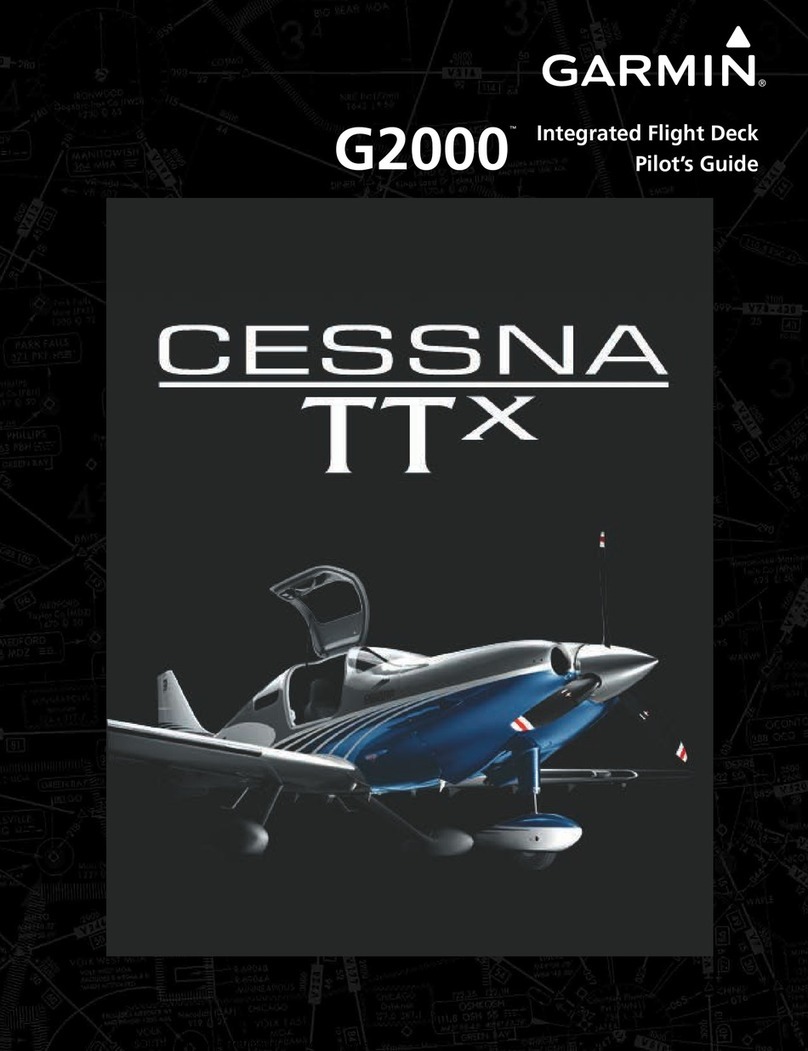
Garmin
Garmin G2000 pilot's guide
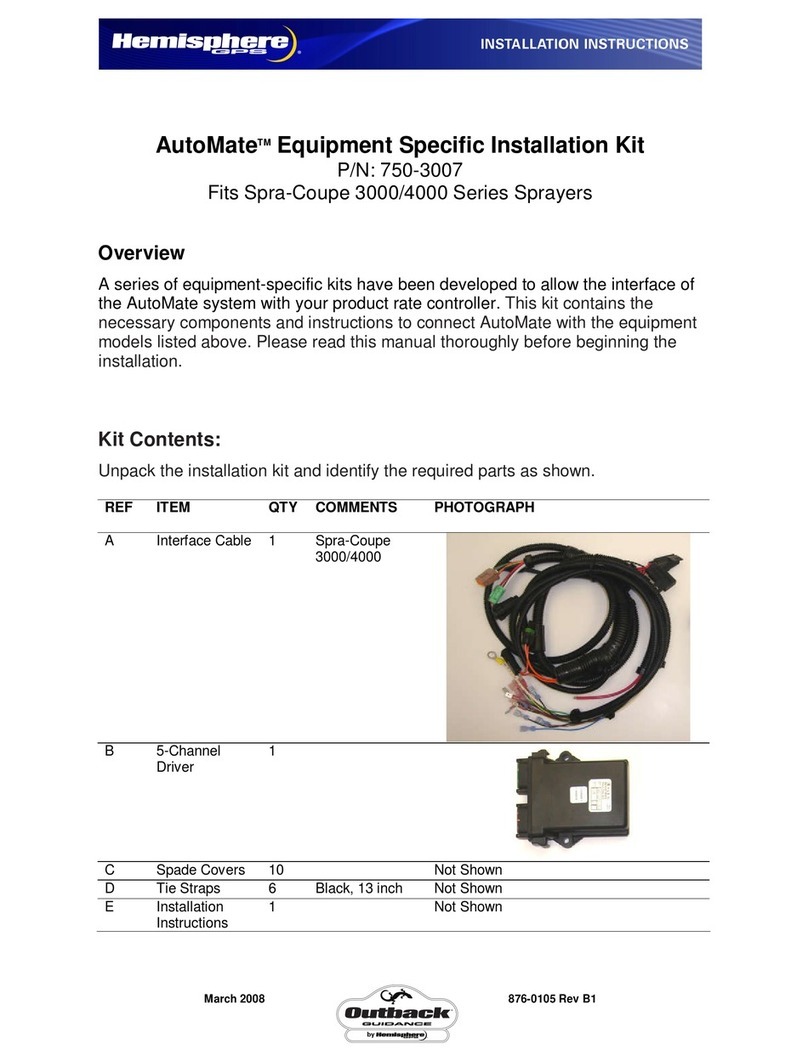
Hemisphere GPS
Hemisphere GPS Outback GUIDANCE AutoMate 750-3007 installation instructions
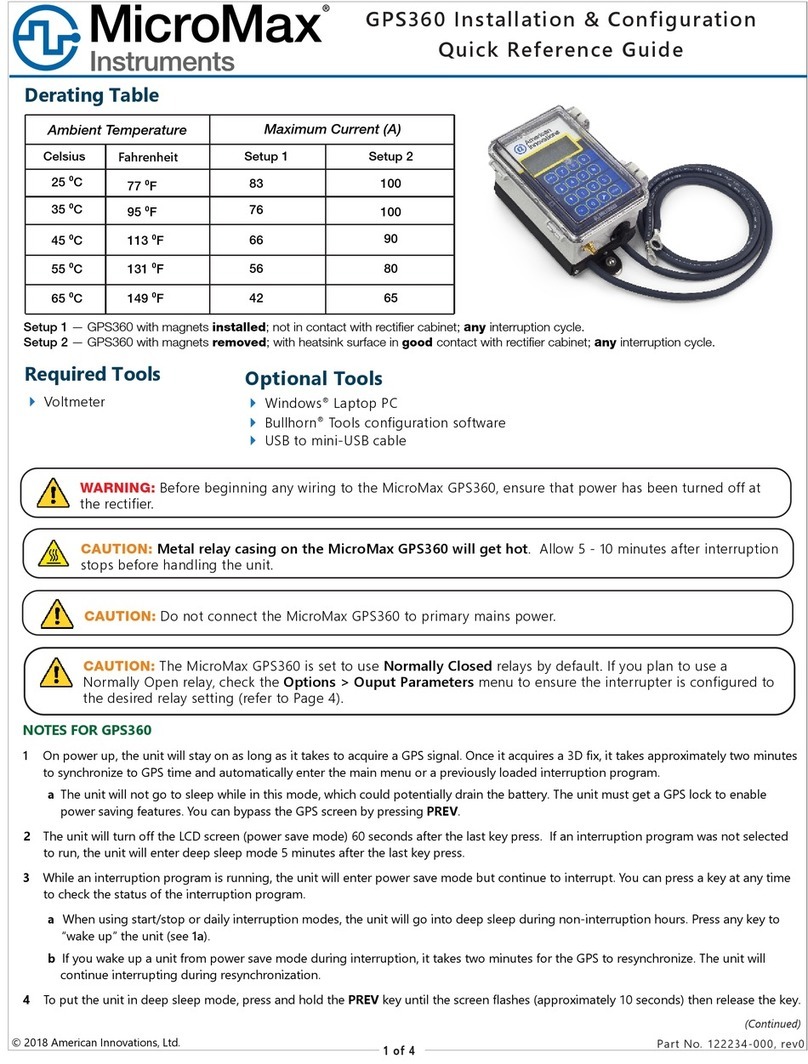
American Innovations
American Innovations MicroMax GPS360 Quick reference guide
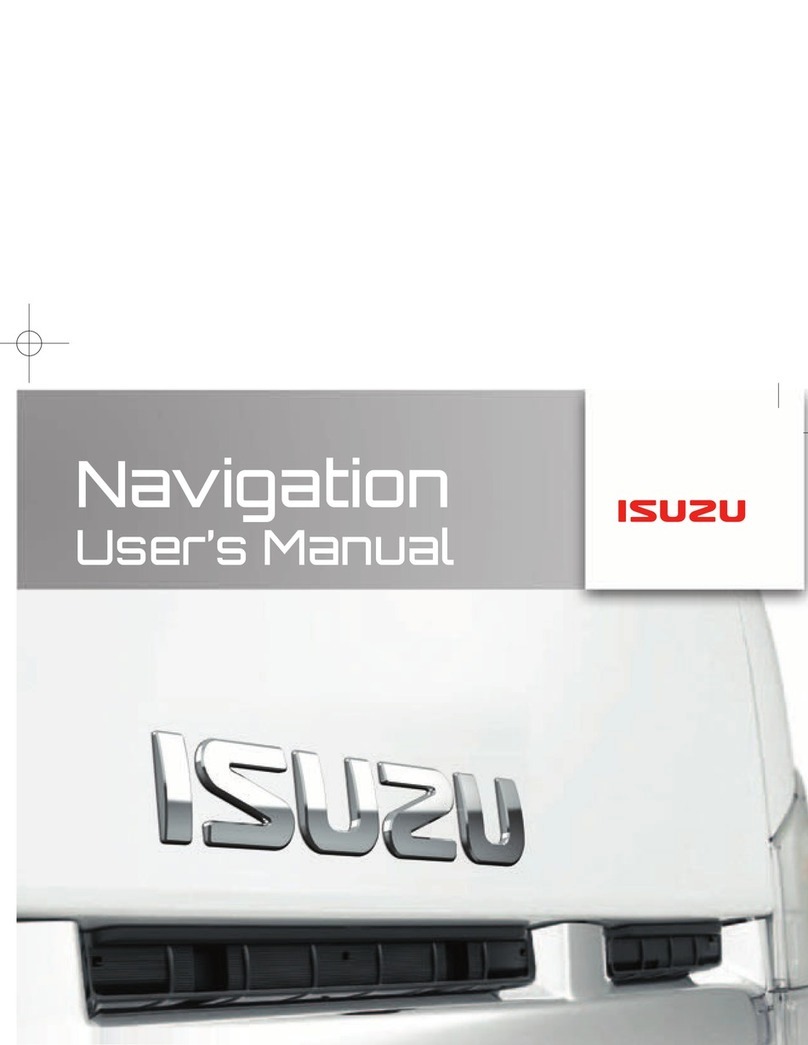
Isuzu
Isuzu GPS Navigation user manual

Voice Caddie
Voice Caddie T8 Quick guidebook
